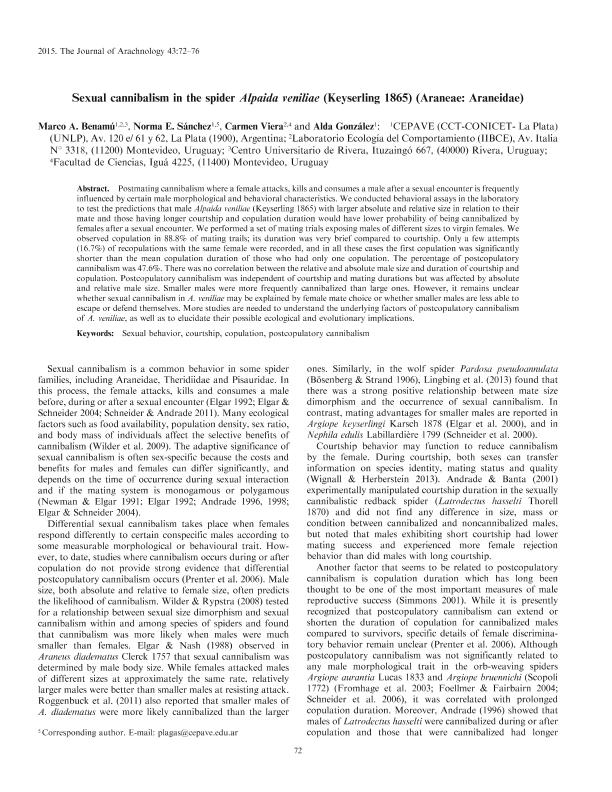Mostrar el registro sencillo del ítem
dc.contributor.author
Benamú, Marco A.
dc.contributor.author
Sanchez, Norma Elba

dc.contributor.author
Viera, Carmen
dc.contributor.author
Gonzalez, Alda

dc.date.available
2016-12-19T20:22:44Z
dc.date.issued
2015-04
dc.identifier.citation
Benamú, Marco A.; Sanchez, Norma Elba; Viera, Carmen; Gonzalez, Alda; Sexual cannibalism in the spider Alpaida veniliae (Keyserling 1865) (Araneae: Araneidae); American Arachnological Society; Journal Of Arachnology; 42; 4-2015; 72-76
dc.identifier.issn
0161-8202
dc.identifier.uri
http://hdl.handle.net/11336/9783
dc.description.abstract
Postmating cannibalism where a female attacks, kills and consumes a male after a sexual encounter is frequently influenced by certain male morphological and behavioral characteristics. We conducted behavioral assays in the laboratory to test the predictions that male Alpaida veniliae (Keyserling 1865) with larger absolute and relative size in relation to their mate and those having longer courtship and copulation duration would have lower probability of being cannibalized by females after a sexual encounter. We performed a set of mating trials exposing males of different sizes to virgin females. We observed copulation in 88.8% of mating trails; its duration was very brief compared to courtship. Only a few attempts (16.7%) of recopulations with the same female were recorded, and in all these cases the first copulation was significantly shorter than the mean copulation duration of those who had only one copulation. The percentage of postcopulatory cannibalism was 47.6%. There was no correlation between the relative and absolute male size and duration of courtship and copulation. Postcopulatory cannibalism was independent of courtship and mating durations but was affected by absolute and relative male size. Smaller males were more frequently cannibalized than large ones. However, it remains unclear whether sexual cannibalism in A. veniliae may be explained by female mate choice or whether smaller males are less able to escape or defend themselves. More studies are needed to understand the underlying factors of postcopulatory cannibalism of A. veniliae, as well as to elucidate their possible ecological and evolutionary implications.
dc.format
application/pdf
dc.language.iso
eng
dc.publisher
American Arachnological Society

dc.rights
info:eu-repo/semantics/openAccess
dc.rights.uri
https://creativecommons.org/licenses/by-nc-sa/2.5/ar/
dc.subject
Sexual Behavior
dc.subject
Courtship
dc.subject
Copulation
dc.subject
Postcopulatory Cannibalism
dc.subject.classification
Zoología, Ornitología, Entomología, Etología

dc.subject.classification
Ciencias Biológicas

dc.subject.classification
CIENCIAS NATURALES Y EXACTAS

dc.title
Sexual cannibalism in the spider Alpaida veniliae (Keyserling 1865) (Araneae: Araneidae)
dc.type
info:eu-repo/semantics/article
dc.type
info:ar-repo/semantics/artículo
dc.type
info:eu-repo/semantics/publishedVersion
dc.date.updated
2016-12-12T14:12:39Z
dc.journal.volume
42
dc.journal.pagination
72-76
dc.journal.pais
Estados Unidos

dc.description.fil
Fil: Benamú, Marco A.. Consejo Nacional de Investigaciones Científicas y Técnicas. Centro Científico Tecnológico la Plata. Centro de Estudios Parasitológicos y de Vectores (i); Argentina. Centro Universitario de Rivera; Uruguay. Instituto de Investigaciones Biologicas "Clemente Estable"; Uruguay
dc.description.fil
Fil: Sanchez, Norma Elba. Consejo Nacional de Investigaciones Científicas y Técnicas. Centro Científico Tecnológico la Plata. Centro de Estudios Parasitológicos y de Vectores (i); Argentina
dc.description.fil
Fil: Viera, Carmen. Facultad de Ciencias; Uruguay. Instituto de Investigaciones Biologicas "Clemente Estable"; Uruguay
dc.description.fil
Fil: Gonzalez, Alda. Consejo Nacional de Investigaciones Científicas y Técnicas. Centro Científico Tecnológico La Plata. Centro de Estudios Parasitológicos y de Vectores (i); Argentina
dc.journal.title
Journal Of Arachnology

dc.relation.alternativeid
info:eu-repo/semantics/altIdentifier/doi/http://dx.doi.org/10.1636/J14-11.1
dc.relation.alternativeid
info:eu-repo/semantics/altIdentifier/url/http://www.bioone.org/doi/abs/10.1636/J14-11.1?journalCode=arac
Archivos asociados
